- europages
- >
- COMPANIES - SUPPLIERS - SERVICE PROVIDERS
- >
- potentiometers
Results for
Potentiometers - Import export

NOVOTECHNIK MESSWERTAUFNEHMER OHG
Germany
If, in a highly sensitive control system, the amplification should, for example, be so arranged that the control circuit will be stable with the mean slope (gradient) of the sensor, then it is important to be aware of any variations there may be in that slope (Fig. 12a, Fig. 12b). If, at any point, the gradient is appreciably steeper than the mean gradient, then there will be a higher closed-loop gain in this position and this could lead to feedback oscillation. If, on the other hand, the gradient is less steep at some point than the mean gradient, then repeatability would be reduced and there would be less control accuracy. If we relate this type of local gradient variation gl to the mean gradient go of the potentiometer, then this criterion is independent of the potentiometer length and can be used for the direct comparision of various potentiometers.
Request for a quote
NOVOTECHNIK MESSWERTAUFNEHMER OHG
Germany
Smoothness is a measure of the deviations from perfect regularity that appear in the output voltage of a potentiometer. This irregularity is measured over a specified travel increment, for example 1 %, and is expressed as a percentage of the applied voltage. For the measurement of smoothness, the VRCI definition calls for a bandpass filter to be used as a means of suppressing any linearity error and for the potentiometer to be operated with a load resistance (e.g. 100 . Rp). This method has certain disadvantages: a) The use of a filter causes both the absolute wiper velocity and any changes in such velocity to affect the smoothness values. Since the filter partly integrates and partly differntiates, the chart-recorded smoothness curve does not accurately indicate the variations in the output signal. b) The load applied to the potentiometer also contributes to error by causing variation in the contact resistance which is greatest with the wiper at the voltage application end and...
Request for a quote
NOVOTECHNIK MESSWERTAUFNEHMER OHG
Germany
When, some 60 years ago conductive plastic potentiometers were first introduced onto the market, it was apparent that although the winding jumps which were a feature of wire-wound potentiometers had been overcome, absolute smoothness of the output voltage could not be achieved. Following some basic reserach by. h. Wormser 4, 5, 6 , the term "smoothness" was included in the standard issued by the Variable Resistive Compontents Institute (VRCI). Although this definition was adequate at that time it cannot serve as a system definition for many applications. This is because it is now possible to produce potentiometers with appreciably better smoothness and linearity values. For this reason, Novotechnik has sought over the past years to develop definitions better suited to the current state fo the art. The various methods used are discussed and evalutated below.
Request for a quote
NOVOTECHNIK MESSWERTAUFNEHMER OHG
Germany
From here onwards, we are only concerned with the linear characteristics (linearity). Relationships must be suitably adapted for applications with non-linear characteristics (conformity) but there are no essential differences. As already mentioned in Section 2, the required linearity values can only be utilized so long as the signal output by the sensor "potentiometer" carries no current. We have now to consider the effect of wiper current on linearity. Fig. 10a illustrates the functional relationship between wiper current, contact resistance and linearity error. As is shown by the example in Fig. 10b (Characteristic 4), with a wiper current of 10 µA and a contact resistance of 10 kOhm, a potentiometer which has a resistance of 2 kOhm already has linearity error of 1.1 %. A similar situation arises with an ohmic load. This clearly shows how important are the roles played by both wiper current and contact resistance. Fig. 10a Fig. 10b
Request for a quote
NOVOTECHNIK MESSWERTAUFNEHMER OHG
Germany
As already indicated under Point 3, conformity is a more general concept than linearity. The definition of absolute conformity is similar to that of absolute linearity. It is essential for an index point to be defined. The functional relationship can either be determined mathematically to be defined. The functional relationship can either be determined mathematically or by plotting a number of points to establish a curve with the aid of suitable interpolation. It is also possible with a potentiometer to achieve steadily increasing or steadily decreasing functions such as logarithmic, exponential, sinusoidal or cosinal functions.
Request for a quote
NOVOTECHNIK MESSWERTAUFNEHMER OHG
Germany
With the ever increasing automation of assembly lines, users are finding that values for absolute linearity are steadily gaining importance. Unlike independent linearity, for absolute linearity the reference slope is fully defined (Fig. 8) so that there is no need for subsequent system trimming. The definition of an index point establishes a relationship between the mechanical input value (travel or angle) and the output voltage. Potentiometers whose linearity is defined by these criteria can be installed without a need for subsequent adjustment. As with independent linearity, it is best to determine the absolute linearity of a potentiometer by comparing its output with that of a master potentiometer. With absolute linearity, it is frequently necessary for the tolerance fields to be stepped. Fig. 9 shows a practical example. Fig. 8 Fig. 9
Request for a quote
NOVOTECHNIK MESSWERTAUFNEHMER OHG
Germany
If a voltage U0 is applied to a potentiometer with a linear characteristic as in Fig. 5 and the wiper is moved in direction Alpha (standardized movement, angle 0;1 ) then the relationship illustrated in Fig. 6 will exist between the output voltage and the mechanically input value. The maximum deviation of the potentiometer curve from an ideal straight line is referred to as the independent linearity error. The slope and axis intercept of this straight line can be so chosen that the error f within the travel L1 is minimized. The error ±f is indicated as a deviation in percentage terms of the output voltage from the theoretical in relation to the input voltage. Since direct measurement of the potentiometer characteristic does not make it possible to assess the extent of such an error, only the difference between the potentiometer characteristic and that of an essentially perfect master potentiometer is plotted as in the practical example given in Fig. 7. Typical values for...
Request for a quote
NOVOTECHNIK MESSWERTAUFNEHMER OHG
Germany
Of all the quality features mentioned, linearity and conformity are the values most often defined in the existing literature (2). These terms express the extent to which the voltage output from a potentionmeter, and also other types of angular of linear movement sensor, differs from a prescribed theoretical function. In by far the majority of cases, the desired output function is directly proportional to the angel or linear movement that is input. Formula: Fig. 5. Whereby m characterizes the gradient, the offset voltage of the potentiometer and the linear or angular travel. Where there is a linear relationship, deviation is referred to as linearity. Where the relationship is nonlinear. U = f (x) + a + b the deviation is referred to as conformity. Fig. 5
Request for a quote
NOVOTECHNIK MESSWERTAUFNEHMER OHG
Germany
When we refer nowadays to a potentiometer as a sensor, it is important to bear in mind the statements made here only apply if the potentiometer is connected as voltage divider rather than as a variable resistor (rheostat) (Fig. 2). The wiper voltage must be connected, free of load, to an operational amplifier such as a 741, OP 07 or some other component with a high input impedance. Fig. 3 explains the terms used, such as electrical and mechanical travel. L1 indicates the defined electrical travel. L2 indicates the continuity travel which also includes the non-linear connection fields Fig. 4. L3 indicates the total electrical contact travel of the potentiometer. L4 indicates the mechanical travel. An electrical potential need not be defined for the whole of this travel. In case of nothing otherwise is defined, the fields L1, L2, L3 and L4 are nominally designed symmetrically. Fig. 2 Fig. 3 Fig. 4
Request for a quote
NOVOTECHNIK MESSWERTAUFNEHMER OHG
Germany
Rapid developments in the fields of control engineering and in microprocessor and semiconductor technology have resulted in the widespread use of electronically controlled systems in every branch of industry today. This has created a need for sensors that are inexpensive but, at the same time, sufficiently robust, both electrically and mechanically, to withstand a wide range of temperatures (e.g. from -40 to +160 degrees centigrade), particularly in applications involving large quantities, such as the automobile industry. Fig. 1 provides a summary of the various types of sensors for angular and linear motion that are in use today. This paper is concerned with quality criteria (1) and (2) applicable to conductive-plastic potentiometers for use as sensors for angular and linear motion. Such potentiometers essentially comprise the following components: 1. The resistance element (support material + a resistance track of conductive plastic) 2. A wiper (precious metal alloy) 3. A...
Request for a quote
NOVOTECHNIK MESSWERTAUFNEHMER OHG
Germany
If there is axial misalignment (eccentricity) between the drive shaft and the shaft of a potentiometer used to sense angular, motion, this will cause a linearity error that increases as the coupling radius decreases in relation to the degree of eccentricity. The following equation determines the maximum relative error Fmax = E/Pi · rk where E = Eccentricity und rk = the coupling radius. It is only possible to take full advantage of the linearity or conformity of any rotationary sensor system, if coupling alignment errors (offset and angular misalignment) are avoided or at least reduced to a mimimum. This means that with highly accurate measurement systems, due allowance must be made for any coupling misalingment in accordance with the above equation.
Request for a quote
SIKO GMBH
Germany
Through hollow shaft Ø 14 mm. Adaptation to various measurement distances owing to a wide range of gear ratios. Compact, low-cost design. Potentiometer or power output. Easy mounting.
Request for a quote
SIKO GMBH
Germany
Solid shaft Ø 4 mm or Ø 6 mm. Adaptation to various measurement distances owing to a wide range of gear ratios. Integrated slip clutch to protect the potentiometer. Compact design. Potentiometer, power or voltage output. IP65 protection category.
Request for a quote
SIKO GMBH
Germany
Extremely resistant to external influences. Solid or blind-hole hollow shaft, max. Ø 20 mm. Adaptation to various measurement distances owing to a wide range of gear ratios. Integrated slip clutch to protect the potentiometer. Potentiometer, power or voltage output. IP65 protection category.
Request for a quote
SIKO GMBH
Germany
Extremely resistant to external influences. Solid or blind-hole hollow shaft, max. Ø 20 mm. Adaptation to various measurement distances owing to a wide range of gear ratios. Integrated slip clutch to protect the potentiometer. Potentiometer or power output. IP65 protection category. Up to 3 cam-operated switch outputs, freely adjustable.
Request for a quote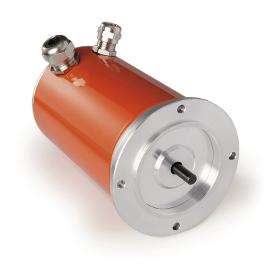
SIKO GMBH
Germany
Solid shaft Ø 6 mm. Adaptation to various measurement distances owing to a wide range of gear ratios. Integrated slip clutch to protect the potentiometer. Compact design. Potentiometer or power output. IP65 protection category. Up to 3 cam-operated switch outputs, freely adjustable.
Request for a quote
SIKO GMBH
Germany
And fine reading. Through hollow shafts up to ø20 mm. Adaptation to various measurement distances owing to a wide range of gear ratios. Integrated slip clutch to protect the potentiometer. Compact design. Potentiometer, power or voltage output. IP68 protection category with oil filling possible. Easy mounting.
Request for a quoteDo you sell or make similar products?
Sign up to europages and have your products listed
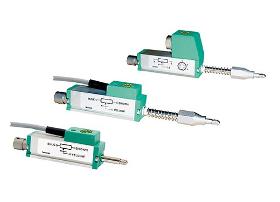
BURSTER PRÄZISIONSMESSTECHNIK GMBH & CO KG
Germany
These displacement sensors are potentiometric displacement sensors used for direct measurement, testing and monitoring of mechanical displacements. The spring-loaded control rod eliminates the need of coupling with the measurement object. A prerequisite for a very long life duration of the devices is a parallel alignment of the motion direction of the measurement object and the rod. Areas of application are: Displacement on: —Electromagnets —Hydraulic cylinders —Switches and buttons Measurements of: —Deformation —Bending —Press-fits —Feed strokes Due to the technology employed in potentiometric displacement sensors, they always operate with a sliding contact system. FEATURES: —Measurement ranges: 0 ... 10 mm to 0 ... 150 mm —Non-linearity up to 0.05 % F.S. —Resolution 0.01 mm —Follower roll on request —Optional with internal spring
Request for a quote
BURSTER PRÄZISIONSMESSTECHNIK GMBH & CO KG
Germany
Displacement sensors models 8710 and 8711 with resistance tracks made of conductive plastic material are designed for a direct and accurate measuring of mechanical displacements. A special ball joint coupling is mountable on both ends of the driving rod. Because of this the sensor may be used free of clearance or lateral forces also with angular or parallel misalignment between sensor and measuring device. A special multi-fingered slider provides a good electrical contact also at high adjustment speeds or vibrations. Areas of application are: —Electromagnets —Switch and button deflections —Pneumatic cylinders —Press-fits (longitudinal press-fits) —Hydraulic cylinders —Measurements of deformation and bending —Length tolerances —Feeding paths Due to the technology employed in potentiometric displacement sensors, they always operate with a sliding contact system.
Request for a quote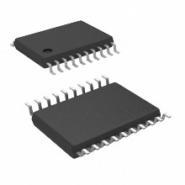
KYNIX SEMICONDUCTOR HONG KONG LIMITED
Hong Kong
The ADI Digital Potentiometer AD5254BRUZ10 is a 10k ohm, 20-pin TSSOP device that provides a digitally controlled variable resistor. It is designed to operate over a temperature range of -40°C to 105°C and has a tolerance of ±30%. It is an I2C device and can be used to adjust the resistance of a circuit in a wide range of applications. Features: • 10k ohm resistance • 20-pin TSSOP package • Operating temperature range of -40°C to 105°C • ±30% tolerance • I2C interface Applications: The ADI Digital Potentiometer AD5254BRUZ10 can be used in a wide range of applications, including: • Adjusting the gain of amplifiers • Adjusting the brightness of LED displays • Adjusting the speed of motors • Adjusting the frequency of oscillators • Adjusting the sensitivity of sensors
Request for a quote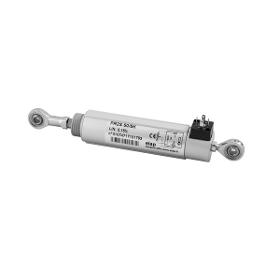
ELAP AUTOMAZIONE INDUSTRIALE
Italy
The linear motion potentiometers series PR2S have a 26 mm diameter round section housing, 5 mm diameter shaft and two ball joints at the ends. Their measuring strokes range from 25 to 150 mm, and their standard resistive value is 5 KOhm. The conductive plastic resistive element grants the transducer a long life (100,000,000 motions), high independent linearity and virtually infinite resolution. The IP65 protection degree against environmental agents allow to employ the potentiometers series PR2S for severe applications, even outdoors, at extreme temperatures. AVAILABLE STROKES mm 25 – 50 – 75 – 100 – 150 AVAILABLE RESISTIVE VALUES 5 KOhm (standard) – Optional: 1 KOhm for PR2S 25
Request for a quote
ELAP AUTOMAZIONE INDUSTRIALE
Italy
The linear motion potentiometers series PR have a 26 mm diameter round section housing and 5 mm diameter shaft. Their measuring strokes range from 25 to 150 mm, and their standard resistive value is 5 KOhm. The conductive plastic resistive element grants the transducer a long life (100,000,000 motions), high independent linearity and virtually infinite resolution. The IP65 protection degree against environmental agents allow to employ the potentiometers series PR for severe applications, even outdoors, at extreme temperatures. The potentiometer PR mounting method is extremely easy: it can be fixed by means of metal clamping brackets, or by the front screw thread. Several fittings are available: ball joint, self-aligning joint, feeler pin.
Request for a quote
ELAP AUTOMAZIONE INDUSTRIALE
Italy
Thanks to their small size – 21 mm square section case – the linear potentiometers seris PT2S can be profitably employed for those applications where limited dimensions are a critical factor. Two ball joints are provided at both ends for air fixing. The series strokes range from 25 to 150 mm. The electrical connection is granted by means of M12 connector. The stout extrused aluminium case grants a high protection degree against environmental agents.
Request for a quote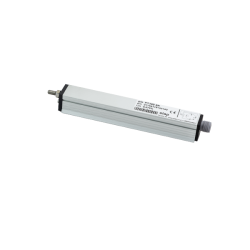
ELAP AUTOMAZIONE INDUSTRIALE
Italy
Thanks to their small size – 21 mm square section case – the linear potentiometers seris PT can be profitably employed for those applications where limited dimensions are a critical factor. The series strokes range from 25 to 150 mm. The electrical connection is granted by means of M12 connector. The stout extrused aluminium housing grants a high protection degree against environmental agents.
Request for a quote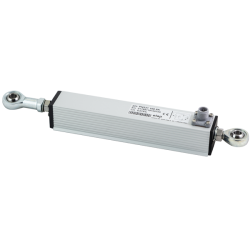
ELAP AUTOMAZIONE INDUSTRIALE
Italy
The linear motion potentiometers series PN231 have a 31 mm square section housing, 8 mm diameter shaft and two fixing ball joints at the ends. Their measuring strokes range from 50 to 750 mm, and their standard resistive value is 5 KOhm. The conductive plastic resistive element grants the transducer a long life (100,000,000 motions), high independent linearity and virtually infinite resolution. The electrical connections are granted by means of M12 connector. Thanks to their high protection degree against environmental agents the potentiometers series PN231 are suited for severe applications, even outdoors, at extreme temperatures.
Request for a quote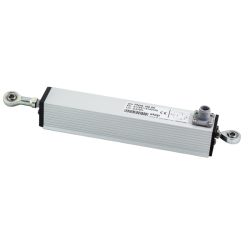
ELAP AUTOMAZIONE INDUSTRIALE
Italy
The linear motion potentiometers series PN2S have a 31 mm square section housing, 6 mm diameter shaft and two fixing ball joints at the ends. Their measuring strokes range from 50 to 750 mm, and their standard resistive value is 5 KOhm. The conductive plastic resistive element grants the transducer a long life (100,000,000 motions), high independent linearity and virtually infinite resolution. The electrical connection is granted by M12 connector. Thanks to their high protection degree against environmental agents the potentiometers series PN2S are suited for severe applications, even outdoors, at extreme temperatures.
Request for a quote
ELAP AUTOMAZIONE INDUSTRIALE
Italy
The linear motion potentiometers series PNS have a 31 mm square section housing and 6 mm diameter shaft. Their measuring strokes range from 50 to 950 mm, and their standard resistive value is 5 KOhm. The conductive plastic resistive element grants the transducer a long life (100,000,000 motions), high independent linearity and virtually infinite resolution. The connections are granted by means of M12 connector. Thanks to their high protection degree against environmental agents the potentiometers series PNS are suited for severe applications, even outdoors, at extreme temperatures.
Request for a quote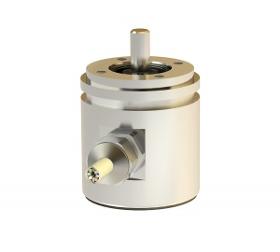
TWK-ELEKTRONIK GMBH
Germany
Robust aluminium or stainless steel housing (wall thicknesses up to 5 mm) - stainless steel shaft and ball bearing - ball bearing with Simmer ring, rotor with shaft and permanent magnet mounted in pre-chamber - sensor circuit consisting of ASIC with Hall elements and interface electronics in enclosed main chamber - housing protection type IP 69K additionally cast - electrical connection via cable (open cable ends).
Request for a quote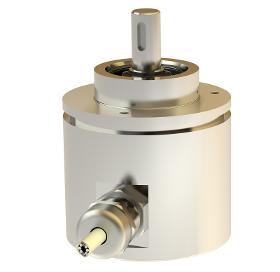
TWK-ELEKTRONIK GMBH
Germany
A positive-locking mechanical connection between the cus-tomer’s shaft and the sensor shaft ensures that the magnet in the sensor shaft precisely reflects the rotation of the cus-tomer’s shaft. With the TBN model, one rotation (i.e. max. 16,384 steps) is recorded.With the subsequent absolute transmission, the TRN shaft encoder reaches a measuring range of up to 4096 rotations. The position and speed values (PDO - Process Data Object) are output via the CANopen protocol.
Request for a quoteResults for
Potentiometers - Import exportNumber of results
121 ProductsCompany type